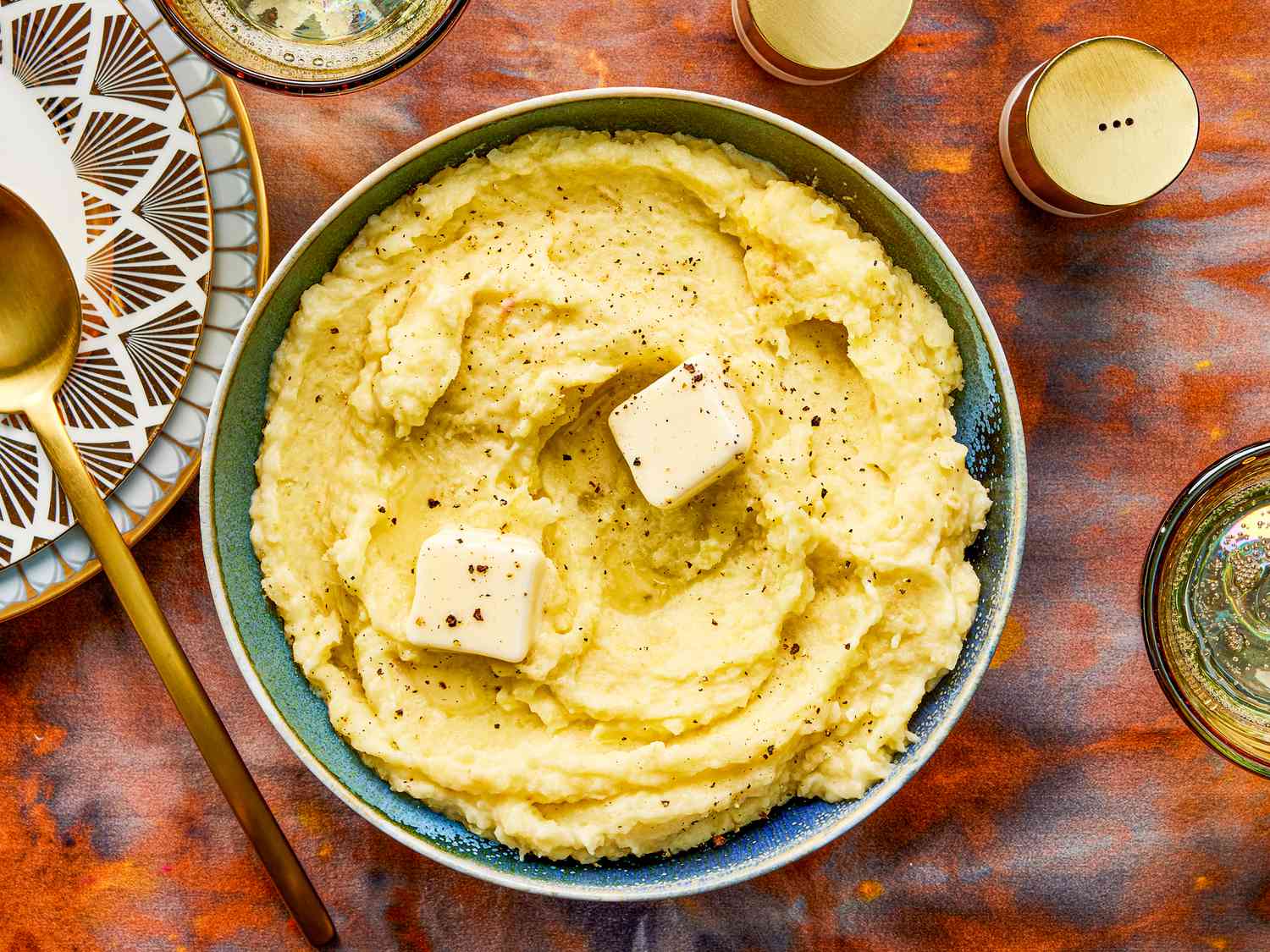
Why It Works
- Adding an entire head of roasted garlic to the mashed potatoes infuses them with sweet mellow garlic flavor.
- Baking the potatoes—instead of boiling them—ensures creamy mashed potatoes.
Every year, my family has a list of “must have” dishes for the Thanksgiving table, and creamy, garlicky mashed potatoes are on the list every time. Starch loaded with butter, cream, and big garlic flavor—what could be better?
As universally loved as garlic mashed potatoes are, they still can cause hushed arguments in the kitchen. Should the texture be more fluffy or silky, what is an acceptable amount of cream and butter, and just how garlicky should the potatoes be?
I like mine to be rich and creamy thanks to plenty of butter and heavy cream, a bit peppery, and loaded with sweet—not harsh—garlic flavor. Unfortunately many versions are unpleasantly gloppy from waterlogged potatoes, lack garlic flavor, or, worse, suffer from an aggressive raw-garlic afterburn.
To nail down a recipe of perfect garlic mashed spuds, we asked our test kitchen colleague Julia Levy to figure out a formula that works every time. They’re special enough for a large holiday meal, but easy enough to whip up any night of the week.
The Key Techniques for Creamy, Garlicky Mashed Potatoes
For sweet garlic flavor, roast—don’t toast—the garlic. Many garlic mashed potato recipes offer quick and efficient methods of incorporating garlic into the mashed potatoes, but those methods come at a price. Some recipes, for example, call for sautéing slivers of garlic in oil or butter, which can brown the garlic but often with the risk of introducing acrid flavors as the garlic scorches in the fat’s high heat. Other recipes have you boil the garlic with the potatoes or in the cream to soften it; this removes its harsh edge but does little to develop the garlic’s flavor beyond “cooked”.
In our opinion, there are few substitutes for the sweet, complex flavor of slowly roasted garlic (garlic confit is another approach we like, but it’s fussier and slower). When roasted, garlic’s sharp edges give way to a rounded, almost candied sweetness that is at once mellow and intense. Once the garlic is cool enough to handle, the browned, softened cloves take on a creamy, paste-like texture and can easily be squeezed out of the skins (squeezing from the root end up) into the potato mixture.
Use yellow potatoes. When it comes to mashed potatoes, not all spuds are created equal; some are highly starchy with a drier, cottony texture, while others are much more moist and silky. Yellow potatoes, such as Yukon Gold, fall into the sweet spot that exists between those two extremes, starchy enough while being satiny soft. They have thin skin, shallow eyes, and creamy, moist flesh that’s best described as naturally buttery, nutty, and slightly sweet. In the potato world, yellow potatoes fall into the “medium starch” category; they have just enough starch to soak up plenty of rich cream and butter and avoid a watery texture, while still producing a wonderfully silky result.
Skip boiling, and bake the potatoes instead. Too much water can contribute to gluey, gummy mashed potatoes. Starch granules exist inside all potato cells. In raw potatoes, these granules are hard and tightly packed. When you boil potatoes—the most common cooking method when making mashed—the starch granules absorb water, swell, and eventually burst, creating a sticky gel. With no fat present at this stage in the process, there’s nothing to stop that gluey, starchy mess for becoming even stickier as you further agitate the potatoes during mashing.
The best way to avoid waterlogged potatoes? Skip boiling them altogether and roast the potatoes whole instead. This cooks the potatoes fully without introducing extra water, leaving the starch available to soak up as much cream as possible—and with all that fat present, gluiness is much less likely to develop.
Serious Eats / Robby Lozano
For this recipe it’s not only a better cooking method for the potatoes, but it’s also practical; the potatoes bake until tender at the same time the garlic roasts right next to it in the oven. It’s a longer cooking process, but it’s all completely hands-off.
Avoid overmixing the potatoes. For super-creamy mashed potatoes, it’s worth investing in a potato ricer or food mill, which are both able to turn the cooked potato into a soft and smooth mash without too much risk of over-mixing (although poor-quality and/or too-small food mills do run some risk). If you don’t mind a chunkier mash, a handheld potato masher is fine, but you’ll want to be wary about overmixing. Whatever you do, skip the food processor and stand mixer—unless garlicky elastic potatoes sound like a good idea to you.
Trending Products










